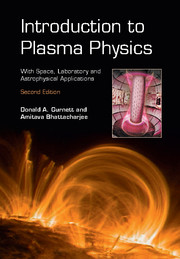Book contents
- Frontmatter
- Dedication
- Contents
- Preface
- 1 Introduction
- 2 Characteristic Parameters of a Plasma
- 3 Single-Particle Motions
- 4 Waves in a Cold Plasma
- 5 Kinetic Theory and the Moment Equations
- 6 Magnetohydrodynamics
- 7 MHD Equilibria and Stability
- 8 Discontinuities and Shock Waves
- 9 Electrostatic Waves in a Hot Unmagnetized Plasma
- 10 Waves in a Hot Magnetized Plasma
- 11 Nonlinear Effects
- 12 Collisional Processes
- Appendix A Symbols
- Appendix B Useful Trigonometric Identities
- Appendix C Vector Differential Operators
- Appendix D Vector Calculus Identities
- Index
- References
7 - MHD Equilibria and Stability
Published online by Cambridge University Press: 16 March 2017
- Frontmatter
- Dedication
- Contents
- Preface
- 1 Introduction
- 2 Characteristic Parameters of a Plasma
- 3 Single-Particle Motions
- 4 Waves in a Cold Plasma
- 5 Kinetic Theory and the Moment Equations
- 6 Magnetohydrodynamics
- 7 MHD Equilibria and Stability
- 8 Discontinuities and Shock Waves
- 9 Electrostatic Waves in a Hot Unmagnetized Plasma
- 10 Waves in a Hot Magnetized Plasma
- 11 Nonlinear Effects
- 12 Collisional Processes
- Appendix A Symbols
- Appendix B Useful Trigonometric Identities
- Appendix C Vector Differential Operators
- Appendix D Vector Calculus Identities
- Index
- References
Summary
This chapter is devoted to the analysis of MHD equilibria and stability. By equilibria, we mean a plasma state that is time-independent. Such states may or may not have equilibrium flows. When the states do not have equilibrium flows, that is, U = 0 in some appropriate frame of reference, the equilibria are called magnetostatic equlibria. When the states have flows that cannot be simply eliminated by a Galilean transformation, the equilbria are called magnetohydrodynamic equilibria. When we introduce small perturbations in a particular equilibrium which is itself time-independent, the time dependence of the perturbations determines the stability of the system. If an equilibrium is unstable, the instability typically grows exponentially in time. The mathematical problem for the stability of magnetostatic equilibria is made tractable due to the formulation of the so-called energy principle. It turns out that when MHD equilibria contain flows that are spatially dependent, the power of the energy principle is weakened significantly, and there has been a general tendency to rely on the normal mode method, for which we provide simple examples.
In nature and in the laboratory, plasmas can be stable according to the equations of ideal MHD. However, even ideally stable plasmas can become unstable in the presence of small departures from idealness, such as a small amount of resistivity. This may appear counter-intuitive upon first glance unless one takes into account the fact that in the presence of even small dissipation the frozen field theorem discussed in Chapter 6 is violated, which enables the plasma to access states of lower potential energy through motions that would be forbidden for ideal plasmas, i.e., by allowing magnetic field lines to slip with respect to the plasma fluid. Such instabilities are called resistive instabilities. These instabilities are part of a general class of phenomena called magnetic reconnection, which is a subject of great interest for space, laboratory, and astrophysical plasmas.
- Type
- Chapter
- Information
- Introduction to Plasma PhysicsWith Space, Laboratory and Astrophysical Applications, pp. 221 - 280Publisher: Cambridge University PressPrint publication year: 2017



